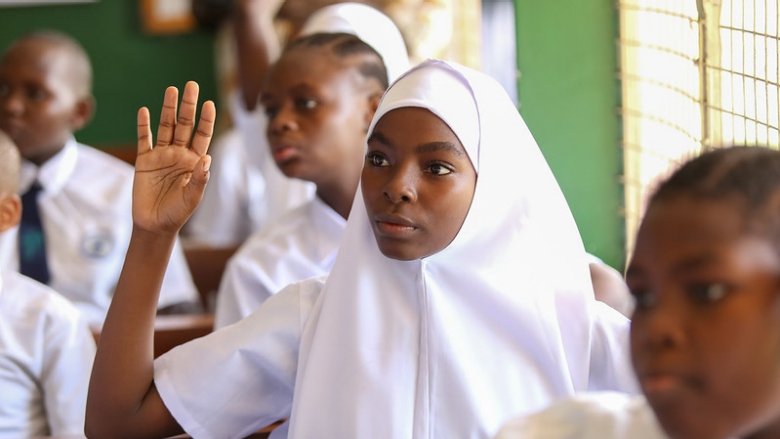The World Bank’s global education strategy is centered on ensuring learning happens – for everyone, everywhere. Our vision is to ensure that everyone can achieve her or his full potential with access to a quality education and lifelong learning. To reach this, we are helping countries build foundational skills like literacy, numeracy, and socioemotional skills – the building blocks for all other learning. From early childhood to tertiary education and beyond – we help children and youth acquire the skills they need to thrive in school, the labor market and throughout their lives.
Investing in the world’s most precious resource – people – is paramount to ending poverty on a livable planet. Our experience across more than 100 countries bears out this robust connection between human capital, quality of life, and economic growth: when countries strategically invest in people and the systems designed to protect and build human capital at scale, they unlock the wealth of nations and the potential of everyone.
Building on this, the World Bank supports resilient, equitable, and inclusive education systems that ensure learning happens for everyone. We do this by generating and disseminating evidence, ensuring alignment with policymaking processes, and bridging the gap between research and practice.
The World Bank is the largest source of external financing for education in developing countries, with a portfolio of about $26 billion in 94 countries including IBRD, IDA and Recipient-Executed Trust Funds. IDA operations comprise 62% of the education portfolio.
The investment in fragile, conflict, or violent (FCV) settings has increased dramatically and now accounts for 26% of our portfolio.
World Bank projects reach at least 425 million students -one-third of students in low- and middle-income countries.
The World Bank’s Approach to Education
Five interrelated pillars of a well-functioning education system underpin the World Bank’s education policy approach:
- Learners are prepared and motivated to learn;
- Teachers are prepared, skilled, and motivated to facilitate learning and skills acquisition;
- Learning resources (including education technology) are available, relevant, and used to improve teaching and learning;
- Schools are safe and inclusive; and
- Education Systems are well-managed, with good implementation capacity and adequate financing.
The Bank is already helping governments design and implement cost-effective programs and tools to build these pillars.
Our Principles:
- We pursue systemic reform supported by political commitment to learning for all children.
- We focus on equity and inclusion through a progressive path toward achieving universal access to quality education, including children and young adults in fragile or conflict affected areas, those in marginalized and rural communities, girls and women, displaced populations, students with disabilities, and other vulnerable groups.
- We focus on results and use evidence to keep improving policy by using metrics to guide improvements.
- We want to ensure financial commitment commensurate with what is needed to provide basic services to all.
- We invest wisely in technology so that education systems embrace and learn to harness technology to support their learning objectives.
Laying the groundwork for the future
Country challenges vary, but there is a menu of options to build forward better, more resilient, and equitable education systems.
Countries are facing an education crisis that requires a two-pronged approach: first, supporting actions to recover lost time through remedial and accelerated learning; and, second, building on these investments for a more equitable, resilient, and effective system.
Recovering from the learning crisis must be a political priority, backed with adequate financing and the resolve to implement needed reforms. Domestic financing for education over the last two years has not kept pace with the need to recover and accelerate learning. Across low- and lower-middle-income countries, the average share of education in government budgets fell during the pandemic, and in 2022 it remained below 2019 levels.
The best chance for a better future is to invest in education and make sure each dollar is put toward improving learning. In a time of fiscal pressure, protecting spending that yields long-run gains – like spending on education – will maximize impact. We still need more and better funding for education. Closing the learning gap will require increasing the level, efficiency, and equity of education spending—spending smarter is an imperative.
- Education technology can be a powerful tool to implement these actions by supporting teachers, children, principals, and parents; expanding accessible digital learning platforms, including radio/ TV / Online learning resources; and using data to identify and help at-risk children, personalize learning, and improve service delivery.
Looking ahead
We must seize this opportunity to reimagine education in bold ways. Together, we can build forward better more equitable, effective, and resilient education systems for the world’s children and youth.
Accelerating Improvements
Supporting countries in establishing time-bound learning targets and a focused education investment plan, outlining actions and investments geared to achieve these goals.
Launched in 2020, the Accelerator Program works with a set of countries to channel investments in education and to learn from each other. The program coordinates efforts across partners to ensure that the countries in the program show improvements in foundational skills at scale over the next three to five years. These investment plans build on the collective work of multiple partners, and leverage the latest evidence on what works, and how best to plan for implementation. Countries such as Brazil (the state of Ceará) and Kenya have achieved dramatic reductions in learning poverty over the past decade at scale, providing useful lessons, even as they seek to build on their successes and address remaining and new challenges.
Universalizing Foundational Literacy
Readying children for the future by supporting acquisition of foundational skills – which are the gateway to other skills and subjects.
The Literacy Policy Package (LPP) consists of interventions focused specifically on promoting acquisition of reading proficiency in primary school. These include assuring political and technical commitment to making all children literate; ensuring effective literacy instruction by supporting teachers; providing quality, age-appropriate books; teaching children first in the language they speak and understand best; and fostering children’s oral language abilities and love of books and reading.
Advancing skills through TVET and Tertiary
Ensuring that individuals have access to quality education and training opportunities and supporting links to employment.
Tertiary education and skills systems are a driver of major development agendas, including human capital, climate change, youth and women’s empowerment, and jobs and economic transformation. A comprehensive skill set to succeed in the 21st century labor market consists of foundational and higher order skills, socio-emotional skills, specialized skills, and digital skills. Yet most countries continue to struggle in delivering on the promise of skills development.
The World Bank is supporting countries through efforts that address key challenges including improving access and completion, adaptability, quality, relevance, and efficiency of skills development programs. Our approach is via multiple channels including projects, global goods, as well as the Tertiary Education and Skills Program. Our recent reports including Building Better Formal TVET Systems and STEERing Tertiary Education provide a way forward for how to improve these critical systems.
Addressing Climate Change
Mainstreaming climate education and investing in green skills, research and innovation, and green infrastructure to spur climate action and foster better preparedness and resilience to climate shocks.
Our approach recognizes that education is critical for achieving effective, sustained climate action. At the same time, climate change is adversely impacting education outcomes. Investments in education can play a huge role in building climate resilience and advancing climate mitigation and adaptation. Climate change education gives young people greater awareness of climate risks and more access to tools and solutions for addressing these risks and managing related shocks. Technical and vocational education and training can also accelerate a green economic transformation by fostering green skills and innovation. Greening education infrastructure can help mitigate the impact of heat, pollution, and extreme weather on learning, while helping address climate change.
Examples of this work are projects in Nigeria (life skills training for adolescent girls), Vietnam (fostering relevant scientific research) , and Bangladesh (constructing and retrofitting schools to serve as cyclone shelters).
Strengthening Measurement Systems
Enabling countries to gather and evaluate information on learning and its drivers more efficiently and effectively.
The World Bank supports initiatives to help countries effectively build and strengthen their measurement systems to facilitate evidence-based decision-making. Examples of this work include:
(1) The Global Education Policy Dashboard (GEPD): This tool offers a strong basis for identifying priorities for investment and policy reforms that are suited to each country context by focusing on the three dimensions of practices, policies, and politics.
- Highlights gaps between what the evidence suggests is effective in promoting learning and what is happening in practice in each system; and
- Allows governments to track progress as they act to close the gaps.
The GEPD has been implemented in 13 education systems already – Peru, Rwanda, Jordan, Ethiopia, Madagascar, Mozambique, Islamabad, Khyber Pakhtunkhwa, Sierra Leone, Niger, Gabon, Jordan and Chad – with more expected by the end of 2024.
(2) Learning Assessment Platform (LeAP): LeAP is a one-stop shop for knowledge, capacity-building tools, support for policy dialogue, and technical staff expertise to support student achievement measurement and national assessments for better learning.
Supporting Successful Teachers
Helping systems develop the right selection, incentives, and support to the professional development of teachers.
Currently, the World Bank Education Global Practice has over 160 active projects supporting over 18 million teachers worldwide, about a third of the teacher population in low- and middle-income countries. In 12 countries alone, these projects cover 16 million teachers, including all primary school teachers in Ethiopia and Turkey, and over 80% in Bangladesh, Pakistan, and Vietnam.
A World Bank-developed classroom observation tool, Teach, was designed to capture the quality of teaching in low- and middle-income countries. It is now 3.6 million students.
While Teach helps identify patterns in teacher performance, Coach leveraged these insights to support teachers to improve their teaching practice through hands-on in-service teacher professional development (TPD).
Our report on Making Teacher Policy Work proposes a practical framework to uncover the black box of effective teacher policy and discusses the factors that enable their scalability and sustainability.
Supporting Education Finance Systems
Strengthening country financing systems to mobilize resources for education and make better use of their investments in education.
Our approach is to bring together multi-sectoral expertise to engage with ministries of education and finance and other stakeholders to develop and implement effective and efficient public financial management systems; build capacity to monitor and evaluate education spending, identify financing bottlenecks, and develop interventions to strengthen financing systems; build the evidence base on global spending patterns and the magnitude and causes of spending inefficiencies; and develop diagnostic tools as public goods to support country efforts.
Working in Fragile, Conflict, and Violent (FCV) Contexts
The massive and growing global challenge of having so many children living in conflict and violent situations requires a response at the same scale and scope. Our education engagement in the Fragility, Conflict and Violence (FCV) context, which stands at US$5.35 billion, has grown rapidly in recent years, reflecting the ever-increasing importance of the FCV agenda in education. Indeed, these projects now account for more than 25% of the World Bank education portfolio.
Education is crucial to minimizing the effects of fragility and displacement on the welfare of youth and children in the short-term and preventing the emergence of violent conflict in the long-term.
Last Updated: Oct 28, 2025












